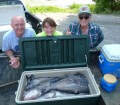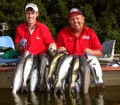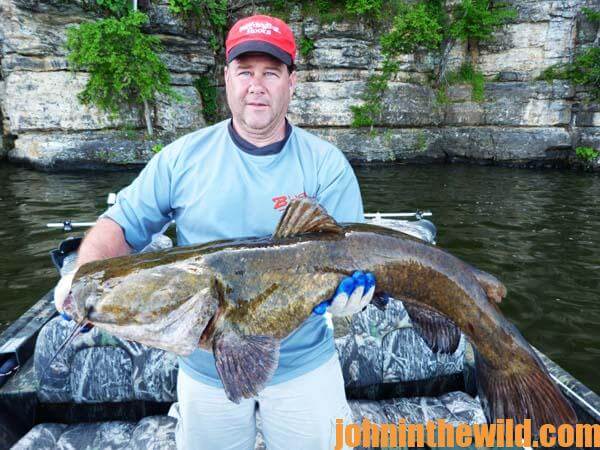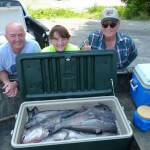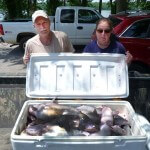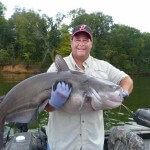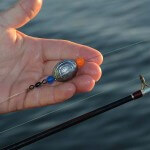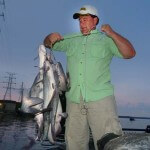John’s Note: Forty-nine-year old Brian Barton of Muscle Shoals, Alabama, has been catfishing for 35 years and guiding anglers for 3-1/2-years on the Tennessee River, one of the premier catfishing waterways in the nation. It’s very fertile, it has mussel beds, it has an abundance of shad, and it has hydroelectric power plants all along the river. Every spring and summer catfishermen from around the nation come to the Tennessee River to catch blue, channel and flathead catfish, expecting to catch 100 pounds of cats per day. I’ve asked Barton to tell us five different ways he catches cats on the Tennessee River that you can use where you catfish. This week we’ve also included videos of Phil King of Corinth, Mississippi – one of the world’s fastest catfish cleaners.
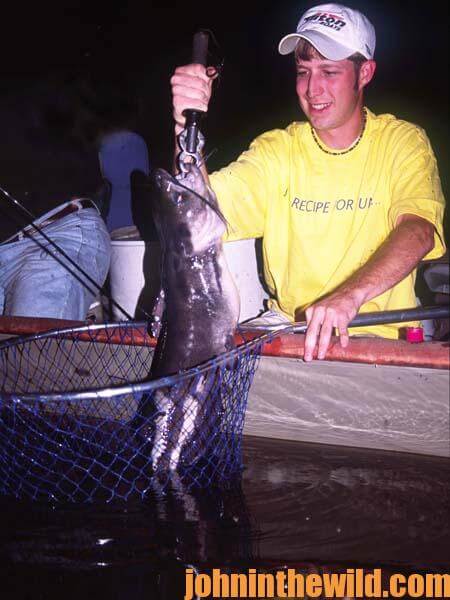 Successful catfishing is much like successful deer hunting. The more you know about the place you’re planning to hunt or fish, the better your odds for taking a deer or catching a catfish.
Successful catfishing is much like successful deer hunting. The more you know about the place you’re planning to hunt or fish, the better your odds for taking a deer or catching a catfish.
Before each lake was backed-up on the Tennessee River in North Alabama, these areas were inhabited by prehistoric people and native people – Indians. The river provided fish and mussels for these people to eat, water for them to drink, fertile river bottom soils with plenty of wild game and a place to plant crops. Many of the early people built burial mounds, ceremonial mounds and shell mounds made of discarded mussel shells. These underwater mounds hold catfish all year long, especially during the summer months. I anchor just upstream and generally to the left or the right of the mounds. I cast out into the current using spinning tackle, a split shot and a live shad minnow. For this technique to work, current must be coming through the lake. I’m going to fish these mounds just like a bass fisherman will. I’ll use either a plastic worm or a tube jig. I let the current wash my bait downstream and over the top of the mound, which is when the catfish generally will attack. If my shot lead hits the bottom, I just raise my rod tip and let the current carry my bait over the top of the mound or hump. I’ve probably caught more numbers of catfish using this technique than I have with any other method.
On my spinning rod, I’ll have 10-pound-test bright fluorescent monofilament. Many times I won’t feel the strike, but I’ll see the line twitch when the catfish nails the bait. That’s when I set the hook. I use a #2 or a #4 bronze baitholder hook and a medium-action spinning rod. The shot lead I use up the line is about a #5 to a #6 and will equal to a 1/8 ounce or 1/4-ounce. When my sinker hits the bottom, I just lightly lift my rod tip. Then, my sinker and bait will wash back over the hump. If I don’t catch a catfish when my line is directly behind the boat, I’ll reel the line in and cast again. My favorite bait is a 3- to 4-inch live shad. If I can’t catch the live shad minnows by throwing a cast net, I’ll use a piece of cut bait.
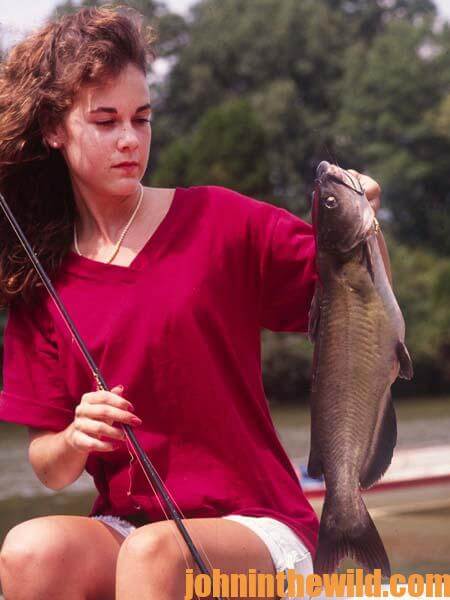 Many of the humps and mounds will be in the middle of the river, because they were usually created close to the old river channel but well up on the bank. I find these mounds by studying artifact books at the Tennessee Valley Authority (TVA). Shell mounds generally were located right on the edge of the old river channel, because the Indians would eat the mussels and throw the mussel shells back in the river. Over the years, those mussel shells created mussel mounds.
Many of the humps and mounds will be in the middle of the river, because they were usually created close to the old river channel but well up on the bank. I find these mounds by studying artifact books at the Tennessee Valley Authority (TVA). Shell mounds generally were located right on the edge of the old river channel, because the Indians would eat the mussels and throw the mussel shells back in the river. Over the years, those mussel shells created mussel mounds.
The dirt mounds will be a little bit away from the edge of the old river channel. When I find an underwater mound with my electronics, I’ve noticed that some of these mounds show up as being harder than other mounds. The mounds that show up the hardest are the mussel shell mounds, and they have a lot of slate rock in them. The earth mounds, which were the ceremonial mounds, and the burial mounds don’t show up on the depth finder as being as hard as the shell mounds.
When TVA decided to dam up the Tennessee River, the company didn’t do a thorough archeological study of these mounds. However, the company did use a steam shovel and cut a trench through some of these earthen mounds to allow the archeologists to do a quick study to learn who may have lived on these mounds, and what was in the mounds. When the lakes were filled up, these mounds were underwater. Also, the trenches that were dug through the mounds were underwater. If you can locate a mound with a trench dug through it, these mounds are the best for catching both catfish and bass, because the fish can hold just below the lip of the trench and let the current bring their bait to them. They only have to move a foot or two to attack the bait fish. You won’t be able to see these trenches on an Avionic chip. You have to pinpoint them with your depth finder.
 To locate productive catfish places on any lake or river, try to look at an archeological map, an aerial photo or any kind of map that shows what the land looked like before it was impounded to create a lake. Your electronics can tell you if you have catfish there or not. A big catfish will create a big arc on your depth finder, depending on the depth finder you use. Because of the heavy bone in a catfish’s head, you may see a red dot on that arc. The smaller catfish will give you horizontal marks about a foot or two off the bottom. Many times you won’t know if these horizontal marks are catfish or bass. Often, crappie and white bass will hold in schools vertically and look like Christmas trees.
To locate productive catfish places on any lake or river, try to look at an archeological map, an aerial photo or any kind of map that shows what the land looked like before it was impounded to create a lake. Your electronics can tell you if you have catfish there or not. A big catfish will create a big arc on your depth finder, depending on the depth finder you use. Because of the heavy bone in a catfish’s head, you may see a red dot on that arc. The smaller catfish will give you horizontal marks about a foot or two off the bottom. Many times you won’t know if these horizontal marks are catfish or bass. Often, crappie and white bass will hold in schools vertically and look like Christmas trees.
I’ve also learned that catfish and bass usually inhabit the same type structure and/or cover. If I’m fishing live shad minnows with one of the technique I’ve described, I may catch 50 fish in a day of fishing, and 25 will be catfish, and the other 25 will be bass. One of the reasons I like to fish live shad minnows is that just about any fish that swims in the Tennessee River will eat a live shad minnow. On our guide trips, we have bent rods most of the day. At times you can catch these shad minnows using a wire dip net along the retaining wall of the dam. However, most of the time, I catch shad minnows in a throw net. I believe the live shad minnows are the best bait you can fish with, but if you can’t get the live shad minnows, buy commercial bass minnows that are about 3- to 4-inches long.
Bonus Videos with Phil King:
To contact Brian Barton you can reach him at [email protected]; you can go to his website at www.brianbartonoutdoors.com. Or, you can visit him on Facebook. On his Facebook page, you can look at more photos of the type and number of fish he’s been catching.For John E. Phillips’ Kindle eBook “Catfish Like a Pro,” click here. You also can download free recipes at johninthewild.com/free-books – “The Catfish Catcher’s Cookbook.”

